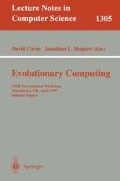Abstract
The CALTROP program which is presented in this paper provides a test of the feasibility of representing a decision tree as a linear chromosome and applying a genetic algorithm to the optimisation of the decision tree with respect to the classification of test sets of example data. The unit of the genetic alphabet (the “caltrop”) is a 3-integer string corresponding to a subtree of the decision tree. The program offers a user a choice of mating strategies and mutation rates. Test runs with different data sets show that the decision trees produced by the CALTROP program usually compare favourably with those produced by the popular automatic induction algorithm, ID3.
Preview
Unable to display preview. Download preview PDF.
References
Buntine W. and Niblett T. (1992) “A Further Comparison of Splitting Rules for Decision-tree Induction” Machine Learning 8, pp 75–86
Cheng J., Fayyad U.M., Irani K.B., and Quian Z. (1988) “Improved Decision Trees: A generalized version of ID3” Proc. 5th International Conf. on Machine Learning, University of Michigan
Culberson J. (1992) Genetic Invariance: a new paradigm for Genetic Algorithm design University of Alberta Technical Report TR92-02 (http://web.cs.ualberta.ca/joe/Abstracts/TR92-02.html)
Ginsberg M. (1993) Essentials of Artificial Intelligence Morgan Kaufman, San Mateo
Langley P. (1996) Elements of Machine Learning Morgan Kaufman, San Mateo
Goldberg D.E. (1989) Genetic Algorithms in Search, Optimisation, and Machine Learning Addison Wesley, Wokingham, England
Goldberg D.E. (1991) “A Comparative Analysis of Selection Schemes used in Genetic Algorithms” in Rawlins G. (ed.) Foundations of Genetic Algorithms pp. 69–93 Morgan Kaufman, San Mateo
Mingers J. (1989) “An Empirical Comparison of Selection Measures for Decision Tree Induction” Machine Learning 3, pp. 319–342
Muggleton S. (1990) Inductive Acquisition of Expert Knowledge Addison Wesley, Wokingham, England
Quinlan J.R. (1986) Induction of Decision Trees Machine Learning 1, pp. 81–106
Quinlan J.R. (1993) C4.5: Programs for Machine Learning Morgan Kaufman, San Mateo
Author information
Authors and Affiliations
Editor information
Rights and permissions
Copyright information
© 1997 Springer-Verlag Berlin Heidelberg
About this paper
Cite this paper
Kennedy, H.C., Chinniah, C., Bradbeer, P., Morss, L. (1997). The contruction and evaluation of decision trees: A comparison of evolutionary and concept learning methods. In: Corne, D., Shapiro, J.L. (eds) Evolutionary Computing. AISB EC 1997. Lecture Notes in Computer Science, vol 1305. Springer, Berlin, Heidelberg. https://doi.org/10.1007/BFb0027172
Download citation
DOI: https://doi.org/10.1007/BFb0027172
Published:
Publisher Name: Springer, Berlin, Heidelberg
Print ISBN: 978-3-540-63476-8
Online ISBN: 978-3-540-69578-3
eBook Packages: Springer Book Archive

